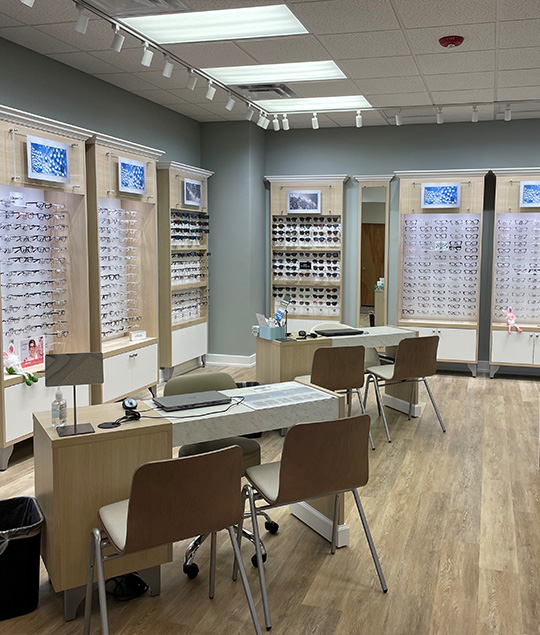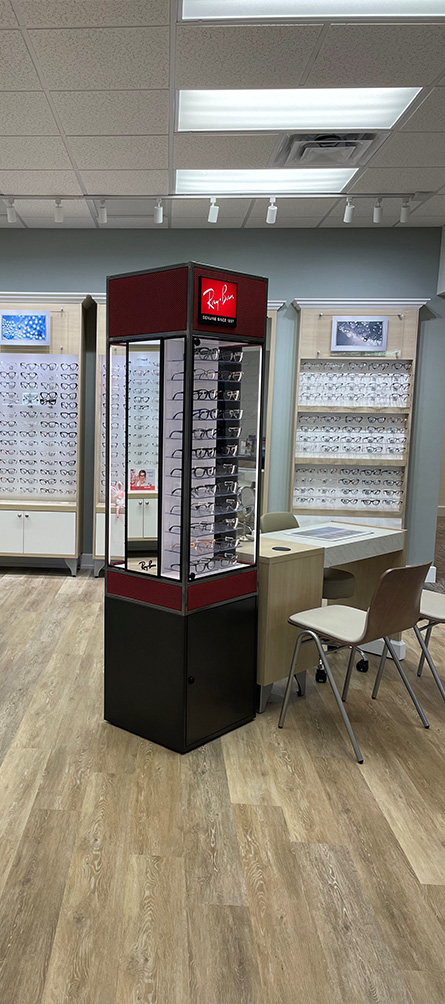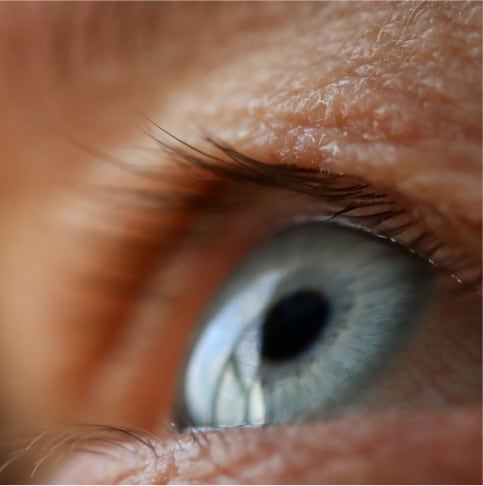Detecting & Diagnosing Eye Diseases
An eye exam is an important part of preventive healthcare. During an eye exam, your ophthalmologist will ensure your eyewear prescription provides the vision you want, and they’ll also check for the development of eye diseases.
Many eye diseases can damage your vision permanently and progress without any noticeable symptoms, particularly in the beginning.
Early identification is crucial for treating and managing eye diseases. If your ophthalmologist catches them early enough, they may be able to slow down progression or prevent vision loss.
Your sight is precious. Safeguard it today with a comprehensive eye exam.
Book AppointmentDiabetic Eye Diseases
People with diabetes are at an increased risk of eye diseases like diabetic retinopathy and diabetic macular edema, which can lead to irreversible vision loss.
Diabetic retinopathy often progresses slowly and, like many eye diseases, may not present visible symptoms until irreversible vision loss occurs. Diabetic macular edema is quite serious and can impact the ability to read, write, drive, and recognize faces.
Both conditions can be identified early with a comprehensive diabetic eye exam. If you have diabetes, book your appointment now.
Book AppointmentGlaucoma
Glaucoma is a group of eye diseases generally characterized by damage to the optic nerve, usually by high intraocular pressure.
Pressure builds up inside the eye, damaging the optic nerve and causing irreversible vision loss. Often, the progression of glaucoma is slow and not easily noticeable, earning the disease the nickname "the silent thief of sight."
There are several types of glaucoma. Click on each title to learn more.
Open-Angle Glaucoma
Fluid buildup caused by blockage of the eye’s drainage channels can increase intraocular pressure (IOP) and cause open-angle glaucoma. Generally, peripheral vision is the first thing impacted, followed by central vision.
Angle-Closure Glaucoma
Angle-closure glaucoma occurs when the space between the iris and cornea narrows, trapping fluid in the eye. When the pressure rises as a result of this fluid, angle-closure glaucoma occurs.
It can appear suddenly (acute) or progress gradually (chronic). Acute angle-closure glaucoma is a medical emergency. Sudden onset headaches, blurry vision, eye redness, or halos appearing around lights mean you should call your ophthalmologist immediately.
Other Types of Glaucoma
Secondary glaucoma occurs when intraocular pressure is caused by eye trauma, injury, or infection.
When the optic nerve is damaged, but intraocular pressure remains within normal range, normal-tension glaucoma may be the cause.
Glaucoma Risk Factors
Glaucoma risk factors may include:
- A family history of glaucoma
- Extreme refractive errors
- Past eye injury or trauma
- Use of certain medications
- Heart disease, diabetes, or high blood pressure
Cataracts
As you age, the clear lens of your eye can thicken and become opaque. This is called a cataract. They are often the result of the normal aging process, though there are cases where cataracts are present at birth.
Symptoms of Cataracts
Cataracts generally develop without pain or redness. Some symptoms of cataracts might include:
- Foggy or blurry vision
- Difficulty seeing at night
- Seeing halos around lights
- Muted color vision
- Sensitivity to light
Preventing Cataracts
Cataract growth can be slowed by protecting the eyes from UV rays—a great pair of sunglasses can help! Eating foods rich in antioxidants like blueberries, apples, artichokes, and dark green veggies like kale and broccoli may also help to prevent cataracts.
Cataract Treatment
Often, obstructions to vision as a result of cataracts can be remedied through corrective lenses. But, cataracts can increase in size and may get to a point where glasses or contact lenses no longer provide the vision you want. In this case, we may recommend surgery.
If you’re having difficulty driving or performing your job safely, are struggling to watch television or read, or are experiencing challenges with daily activities that decrease your quality of life, it might be time to explore surgery.
Cataract surgery is safe and effective, and we will help you understand the procedure and your options.
Age-Related Macular Degeneration
Age-related macular degeneration (AMD) causes the breakdown of the macula, the area of the eye responsible for central vision. Damage to the macula can lead to central vision loss.
The central vision is responsible for reading, writing, driving, and recognizing faces, so any loss of vision in this area may make day-to-day tasks difficult.
People with AMD may not experience any pain or symptoms as the disease progresses. If straight lines begin to appear wavy or your central vision blurs in a way that glasses cannot correct, it’s time for an eye exam.
There are 2 types of AMD: dry and wet.
Dry AMD
Dry AMD is the most common type of AMD, accounting for the majority of cases. It occurs when parts of the macula become thinner due to aging and accumulate tiny clumps of protein.
Wet AMD
The less common type of the disease, wet AMD, is responsible for the majority of cases of blindness as a result of AMD. Wet AMD occurs when blood vessels grow under the retina and leak fluid into the macula.
We're on the Lookout for Early Signs of Eye Disease
Regular, comprehensive eye exams are the best defense against eye diseases that can cause irreversible vision loss.
Book your appointment today, and let us examine your eyes for early signs of eye disease so you can preserve sight of you and your loved ones.
Book AppointmentBelow are summaries of eye diseases and conditions that you are experiencing or could face in the future. Please keep in mind that the below information if for general education purposes only and if you suspect that you have an eye or vision problem please contact us immediately.
Astigmatism
Astigmatism is a condition of the cornea, which is the clear front portion ofthe eye. In a “perfect eye” the cornea would be completely spherical like a marble. In reality few people have a completely spherical cornea. When the cornea shows some curvature, like rolling hills on a golf course, the condition is called astigmatism. The irregular curvature of the cornea in astigmatism causes light to be scattered in different directions. Symptoms of astigmatism include blurred vision, eyestrain or distorted vision. Options for correction of astigmatism include glasses, soft contact lenses, rigid contact lenses and implants after cataract surgery.
Blepharitis
Blepharitis is chronic inflammation of the eyelids and eyelashes. The inflammation can be due to bacteria or various skin conditions. Symptoms of blepharitis include itching, burning, crusting, blurring of vision and redness. Blepharitis can cause patients to develop styes, or chalazia. Severe cases of blepharitis can cause permanent damage to the eyelids or eyes. Treatment of blepharitis includes lid hygiene measures and medications.
Cataracts
A cataract is when the body’s natural lens shows aging changes. The lens is a structure that sits behind the colored part of the eye called the iris, and serves to bend light onto the retina to allow clear vision. The lens is typically crystal clear at birth, but over time shows aging changes due to protein accumulation and free radical damage. When the lens starts to show this aging change it is called a cataract. Most cataracts gradually get worse over time, although some types of cataracts can progress quickly. Most people will get cataracts if they live long enough although sun exposure, smoking, diabetes and eye injuries can hasten the development of cataracts. Symptoms of a cataract include blurred or dim vision, yellowing or dimming of colors, problems with glare or haloes from bright lights at night, feeling like vision is “frosted” or “filmy” and double vision. Once a cataract is diagnosed, the treatment is to surgically remove the cataract and put in a lens implant in its place. There are different options for lens implants, including some that help to correct for astigmatism and some that allow distance up close and far away without glasses. In the vast majority of cases, cataract surgery is an elective procedure. The decision to have cataract surgery is up to the patient, and is often made when the patient feels the cataract is interfering with activities of daily living.
Diabetic Eye Disease
Diabetes is a systemic disease that can cause changes in the eye. Diabetic changes in the eye can include changes in glasses prescription, corneal problems and changes in the back of the eye. Often there are early diabetic changes in the back of the eye that appear before the patient is aware of any vision changes. Early identification of these diabetic changes can help to prevent further damage. In the event that diabetic damage does occur, we work closely with retina specialists to facilitate treatment.
Diplopia
Diplopia, or double vision, is a condition in which patients see ghosting, shadowing or two distinct separate images. The images may be side-by-side, up-and-down or diagonal from each other. In some cases of diplopia, closing one eye or the other helps the double image to disappear. There are many different causes of diplopia including dry eye, cataract, astigmatism, eye muscle disorders, thyroid eye disease and stroke. New onset diplopia should be evaluated promptly to rule out a serious cause. Treatment of diplopia depends on the cause, and may include eye drops, glasses, cataract surgery, prisms in glasses or eye muscle surgery.
Dry Eye Syndrome
Duct Obstruction
Nasolacrimal duct obstruction is a condition affecting the tear drainage system. Each eye has two puncta (in the inner corners of each eyelid), which drain tears from the eye. The tears then travel through the tear drainage system and ultimately exit in the nose. If there is an obstruction along this tear drainage system it can cause a reflux of tears, discharge, redness and crusting. Nasolacrimal duct obstruction can affect both pediatric and adult patients. In pediatric patients, patients present from birth with tearing, discharge and redness from one or both eyes. 90% of pediatric patients with a nasolacrimal duct obstruction will have spontaneous resolution within the first year of life. In older patients, nasolacrimal duct obstruction is usually an acquired condition that rarely resolves on its own. In a pediatric patient with a nasolacrimal duct obstruction that does not spontaneously resolve, a probing procedure can often fix the issue. In adult patients with nasolacrimal duct obstruction, a more extensive surgical procedure may be required for treatment.
Eye Infections
There are many different types of eye infections that affect different structures within the eye. Infections can range from mild to severe, and can have varying effects on vision. Common infections include conjunctivitis, which is an infection affecting the clear outer coating of the eye called the conjunctiva. Conjunctivitis can be due to bacterial or viral causes. Another common type of eye infection, particularly in contact lens wearers, is a corneal ulcer. A corneal ulcer is an infection of the cornea, or clear front portion of the eye. Less commonly patients can develop an infection of the retina, which can result in severe vision loss. Antiviral, antifungal or antibiotic medications are used to treat eye infections. Prompt evaluation of eye infections is important to help prevent vision damage.
Eye Injuries
Eye injuries are common, and can range from mild to severe. Common examples of eye injuries seen in our practice include corneal abrasions, corneal or conjunctival foreign bodies, eyelid cuts or lacerations, subconjunctival hemorrhages and blunt force eye injuries. A severe injury can cause damage to the eye that requires urgent surgical intervention. If you have an eye injury, it should be evaluated as quickly as possible to rule out a severe injury. Early treatment of eye injuries can help the eye feel better and prevent vision damage.
Eye Lid Cyst (Chalazion)
A chalazion is a blocked oil gland of the eyelid. Many people refer to chalazia as styes. If the blocked oil gland is near the skin, the chalazion may present as a bump on the outside of the eye. If the blocked oil gland is within the eyelid, the chalazion may present as a bump within the eyelid. If the chalazion becomes significantly inflamed or infected it may cause redness, swelling and pain of the eyelid and this is known as a hordeolum. Treatment of a chalazion or hordeolum varies. In general, hordeola require antibiotics to quiet the infection. Some chalazia respond to frequent warm compresses and anti-inflammatory ointments. Other chalazia require steroid injections or incision and drainage to resolve. Although unsightly, chalazia rarely pose a threat to vision.
Eyelid Growths
Growths on or around the eyelids affect many patients. In the majority of cases the eyelid growths are benign lesions such as papillomas or cysts. However, skin cancers such as basal cell carcinoma or squamous cell carcinoma can also affect the eyelid. We are able to do excisional biopsies and lesion removals in our office and send all specimens to pathology for definitive diagnosis.
Flashes and Floaters
Flashes and floaters are a common ocular complaint. In most cases flashes and floaters occur when the gel that occupies that back portion of the eye (the vitreous) becomes separated from the back layer of the eye (the retina). In some cases as the vitreous separates from the retina it can cause a retinal hole, tear or detachment. Early identification and treatment of a retina hole, tear or detachment can prevent permanent vision damage. Therefore, if you develop any new flashes or floaters it’s important to have them evaluated as soon as possible to rule out any retinal damage.
Glaucoma
Glaucoma is one of the most common causes of permanent vision loss. Glaucoma is a disease of the optic nerve, which is the nerve that connects the eye to the brain. Over time glaucoma causes gradual damage to the optic nerve that first results in peripheral vision loss. If the optic nerve damage continues, it can ultimately cause tunnel vision or complete loss of vision. Although the relationship between glaucoma and eye pressure is not entirely understood, we do know that lowering eye pressure helps to slow or prevent optic nerve damage in glaucoma. In most cases glaucoma is a painless disease, and because it affects peripheral vision first, many patients are not aware of vision changes until they are quite severe. Therefore it’s important to have regular eye exams to help screen for this condition. Diagnosis and treatment of glaucoma requires several tests including a visual field test, optic nerve OCT, evaluation of your eye drainage system and measuring of your corneal thickness. Treatment of glaucoma can include drops to lower pressure, lasers or surgical procedures. Early identification and treatment of glaucoma can help prevent permanent vision loss.
Herpetic Eye Disease
Herpes is a virus that affects many parts of the body, including the eye. There are different types of herpes virus including Herpes simplex, which causes cold sores and Varicella zoster, which causes chicken pox and shingles. Herpetic infection of the eye can cause redness, eye pain, inflammation, eyelid swelling and tearing. Severe herpetic infections can cause retinal disease and vision damage. Treatment of herpetic eye disease often consists of eye drops and oral medications. Some types of herpetic eye disease require long-term treatment to prevent flare-ups of symptoms.
Hyperopia
Hyperopia, or “far-sightedness” is an eye condition in which the eye is too short or the cornea is too flat. These changes in the eye cause light to be reflected behind the eye, instead of on the retina, which results in blurred vision. Patients with hyperopia have blurred vision up close, but often also have blurred vision in the distance. Glasses or contact lens correction is the most common treatment of hyperopia.
Amblyopia
Amblyopia is a condition originating in childhood as a result of one or both eyes not developing proper vision. Amblyopia can be due to uncorrected refractive error, crossing of eyes, obstruction of vision by a drooping eyelid or injury. Over time, if one or both eyes do not see well, the brain shuts off the visual pathway to the eye and vision cannot develop normally. Amblyopia can result in permanently poor vision if not identified and treated at a young age. Treatment for amblyopia can include eyeglasses, patching and eye drops. Some cases of amblyopia need surgical correction. It’s important to identify amblyopia as early as possible so that corrective measures can be taken and visual development can proceed normally.
Macular Degeneration
Macular degeneration is an aging change of the retina, which is the back surface of the eye. Macular degeneration affects the macula, which is the part of the retina that’s responsible for central vision. Symptoms of macular degeneration include blurred vision, distorted vision, difficulty with reading, problems with contrast sensitivity, difficulty recognizing faces, or problems seeing the food on a plate. There are two types of macular degeneration: Wet macular degeneration and dry macular degeneration. In dry macular degeneration, deposits and scarring develop in the macula, causing vision changes. In some cases of dry macular degeneration vitamins may help to slow the disease progression. In wet macular degeneration, abnormal blood vessels grow in the macula, causing bleeding and swelling. Laser and eye injections can be used to treat wet macular degeneration and help to improve vision in some cases. After identification of macular degeneration, we work closely with retina specialists to ensure the best treatment option for our patients.
Myopia
Myopia, or “near-sightedness” is an eye condition in which the eye is too long or the cornea is too strong. These changes in the eye cause light to be reflected in front of the retina, instead of on the retina, which results in blurred vision. Patients with myopia have blurred vision in the distance, but often see well up close. Glasses or contact lens correction is the most common treatment of hyperopia.
Ocular Allergies
Many people in North Central Florida suffer from seasonal allergies, and these allergies can often affect the eye. Common symptoms of ocular allergies include eyelid swelling, eye redness, itchiness, irritation and blurred vision. Many times ocular allergies are mistaken as pink eye, or infectious conjunctivitis. Treatment of ocular allergies consists of eye drops and systemic medications.
Pseudotunor Cerebri (IIH)
Idiopathic intracranial hypertension (IIH) is a condition in which an excess amount of cerebral spinal fluid builds up within the brain, in the absence of a tumor or other cause that could block the outflow of the spinal fluid. IIH is diagnosed with a spinal tap and an MRI. Symptoms of IIH include headache, momentary loss of vision with changes in posture, a “whooshing” sound in the ears and double vision. IIH most commonly occurs in overweight women, although it can occur in children, men and women of normal weight as well. Some medications such as tetracyclines, birth control and Accutane can cause IIH. If a patient is diagnosed with IIH they require close vision screening to ensure that there is no optic nerve damage and subsequent vision damage due to the elevated cerebral spinal fluid levels. Treatment of IIH is a multidisciplinary approach with neurology, ophthalmology and sometimes neurosurgery. Weight loss, oral medications and surgical procedures are all used to help treat IIH.
Pterygium
A pterygium is a growth of the conjunctiva, which is the clear, vascularized, outer layer of the eye. In response to chronic sun and wind exposure, the conjunctiva begins to grow onto the cornea, where it appears as a white growth onto the clear front part of the eye. In some cases pterygia are asymptomatic, but in other cases they can cause redness, irritation or visual changes. The definitive treatment for a pterygium is surgical excision, although they can sometimes recur after surgery.
Thyroid Eye Disease
Although most cases of thyroid eye disease occur in the setting of hyperthyroidism, patients with hypothyroidism can also develop symptoms. Thyroid eye disease can present with a bulging of the eyes, eyelid retraction, dry eyes, redness, blurred vision, double vision and in rare cases vision loss. Although mild thyroid eye disease can be treated with lubrication and monitoring, severe thyroid eye disease may require surgical procedures on the orbit, eyelid or eye muscles. Patients with a history of any type of thyroid disorder should have their eyes evaluated periodically.
Vitreous Detachment
The vitreous is a body of gel that sits in the back portion of the eye and is attached to the retina, the back surface of the eye. Over time the consistency of the vitreous changes, and it has a tendency to pull loose from the retina. Sometimes a head or eye injury can cause a sudden vitreous detachment. Vitreous detachments present to the patient as floaters and flashes. In some cases a vitreous detachment can cause damage to the retina. If you develop new flashes or floaters it’s important to have them evaluated to rule out retinal damage.
Premiere Vision Care Center














